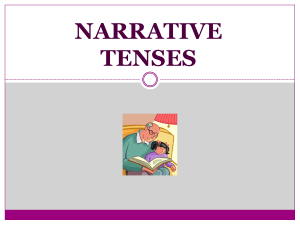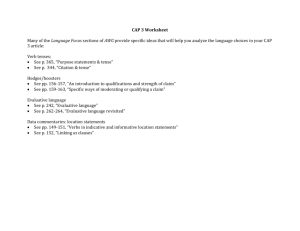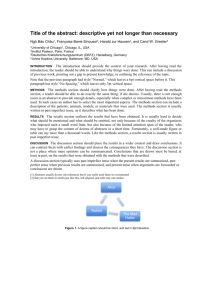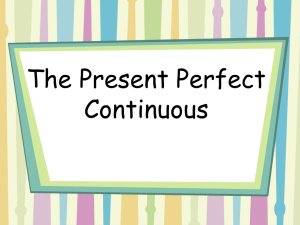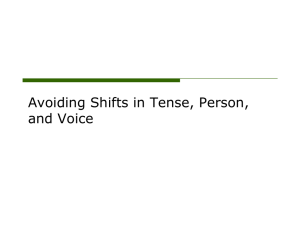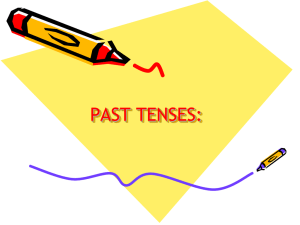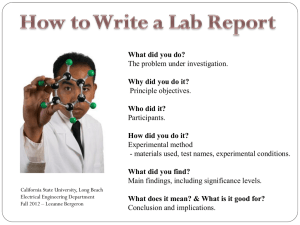View/Open - Hasanuddin University
advertisement
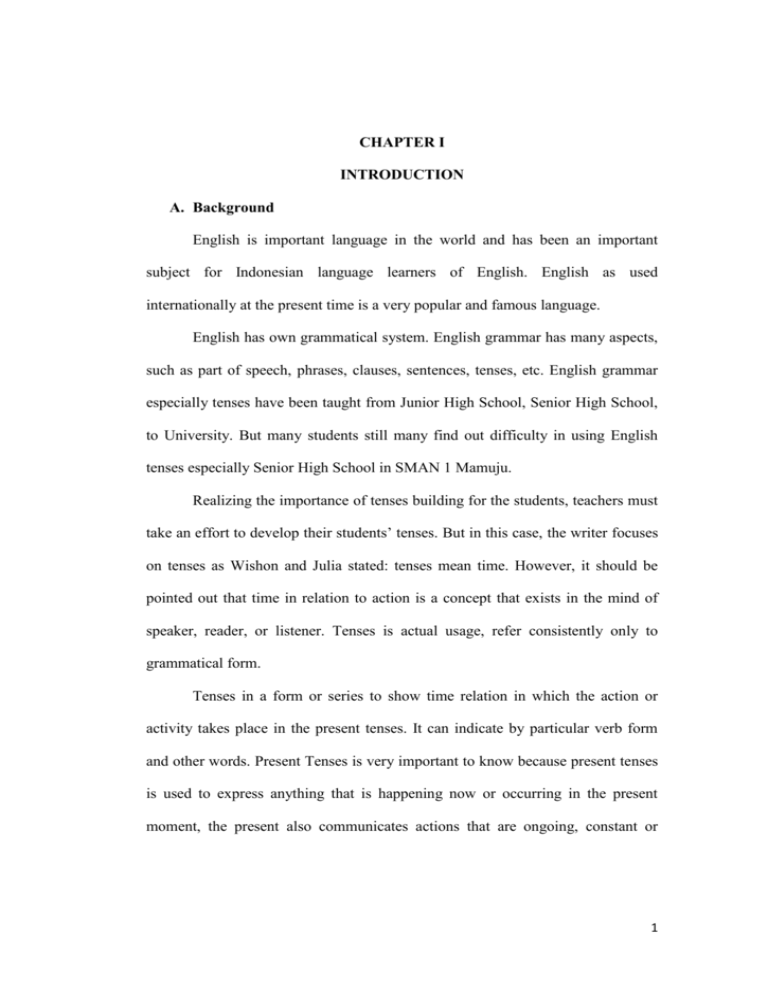
CHAPTER I INTRODUCTION A. Background English is important language in the world and has been an important subject for Indonesian language learners of English. English as used internationally at the present time is a very popular and famous language. English has own grammatical system. English grammar has many aspects, such as part of speech, phrases, clauses, sentences, tenses, etc. English grammar especially tenses have been taught from Junior High School, Senior High School, to University. But many students still many find out difficulty in using English tenses especially Senior High School in SMAN 1 Mamuju. Realizing the importance of tenses building for the students, teachers must take an effort to develop their students’ tenses. But in this case, the writer focuses on tenses as Wishon and Julia stated: tenses mean time. However, it should be pointed out that time in relation to action is a concept that exists in the mind of speaker, reader, or listener. Tenses is actual usage, refer consistently only to grammatical form. Tenses in a form or series to show time relation in which the action or activity takes place in the present tenses. It can indicate by particular verb form and other words. Present Tenses is very important to know because present tenses is used to express anything that is happening now or occurring in the present moment, the present also communicates actions that are ongoing, constant or 1 habitual. In using English tenses, there are still many Indonesian learners who make mistake. These mistakes are made due to their lake of knowledge about the roles of English tenses. Therefore, many Indonesian learners often find grammar difficult especially these aspects that concern the sentences structure. Based on reason above, the writer is interested to do her research entitle: “Students Ability in Using Present Tenses (A case Study in SMAN 1 Mamuju). B. Statement of Problem The writer tries to observe and analyze of the following problem: 1. How far is the student ability in using present tenses, such as simple present tense, present continuous tense, present perfect tense and present perfect continuous tense? 2. What kind of the difficulties faced by students of SMAN 1 Mamuju? C. Objective of Research Based on the research question above, the writer states that the objective of the research is a follows: 1. To find out the students ability in using present tenses. 2. To describe the kinds of the difficulties faced by students in SMAN 1 Mamuju. 2 D. Significant of Research In this writing, writer hopes students in SMAN 1 Mamuju get a good grammar, and to be able to increase her knowledge. 3 CHAPTER II THEORITICAL BACKGROUND A. Previous studies There are some of the researches, dealt with tenses in the classroom. They are: 1. Ardiyansyah (Unhas,2011) in his research entitled “The Ability of the Second Years Students of SMAN 11 Makassar to use Past Tenses”. Focused on simple past tense, past continuous tense, present perfect tense. The result is the ability of students in SMAN 11 Makassar in using simple past tense, past continuous tense, and present perfect tense is classified as “very poor”. 2. Mustajab (Unhas, 2007) in his research entitled “Using Tenses by Student English Department year 2007 Hasanuddin University”. Focused on simple present tense, simple past tense, and simple future tense. The result is the ability of students in English Department year 2007 Hasanuddin University in using simple present tense, simple past tense, and simple future tense is classified as “excellent”. 3. Aminah (Unhas 2004) in her research entitled “The Ability in Using English Tenses by Student of Madrasah Aliyah Wawerang Flores Timur”. Focused on simple present tense, present continuous tense, simple past tense. The result is the ability of students in Madrasah Aliyah Wawerang Flores Timur in using simple present tense, present continuous tense, and simple past tense is classified as “fail”. 4 The three researches are valuable, because the studies give some references about tenses to this writing. Besides, from the researches, the writer finds out comparison of students’ ability in different kind, time, and place. In this research, the writer discussed about “students ability in using present tenses, this is a case study at SMAN 1 Mamuju)”. Present Tenses is very important to know because Present Tenses is used to express anything that is happening now or occurring in the present moment, the present also communicates actions that are ongoing, constant or habitual. This research is quite different from the three researches above because they just figure out the ability to use tenses. However, in this thesis, beside the using of tenses the writer also deal with passive voice and active voice point of view. B. Theoretical framework 1. Grammar In common, grammar is the rule for forming words and making sentence, beside there are many definitions above grammar. While, Cook, (1991) define grammar as in the following: a. Perspective grammar that prescribes what people should say. It is the rules found in school-books; say the warnings against final preposition in sentence. b. Structural grammar concerned with how words go into phrases structure, which shows how some words go together in the sentences. c. Grammar as knowledge, it refers to the native speakers’ knowledge of language. 5 Simon and Schuster, (1976) define grammar as in the following: a. Grammar as knowledge refers to the native speakers’ knowledge of language. b. The system of word structures and words arrangement of a given language the given time. c. The system of rules for speaking and writing a given language. d. One manner of speaking or writing. It has to be learned because the valuable transmission in speech through the understanding of structural pattern. Based on the above statement, the writer can concludes that grammar is the structure and system of a language. Grammar can help to learn a language more quickly and more efficiently. 2. Sentences a. Definition of Sentence Sentence is a grammatical unit that is syntactically independent and has a subject that is expressed or, as in imperative sentences, understood and a predicate that contains at least one finite verb. Frank (1972:220) states a sentence is a full predication containing a subject plus a predicate with a finite verb. Its arrangement may be symbolized by such formulas as S + V + O (Subject + Verb + Object), N1 + V + N2 (Noun + Verb + Noun) or NP + VP (Noun Phrase + Verb Phrase) Based on the above statement, the writer can conclude that sentence can be also defined as a group of words which start with capital letter and ends with full stop, question mark, or exclamation mark. A sentence contains or implies a predicate and a subject. 6 b. Types of Sentence According to Blake (1988:125:126) outlined four types of sentences in English: declarative, interrogative, exclamatory, and imperative. There are: 1) Declarative Sentence A declarative sentence makes a statement. A declarative sentence ends with a period. (Sentences are simple statements. Such as; state, assert, or declare something). For example: The house will be built on a hill. The eagle is flying. 2) Interrogative Sentence An interrogative sentence asks a question. An interrogative sentence ends with a question mark. For example: Where do you live? Can I borrow your newspaper? 3) Exclamatory Sentence An exclamatory sentence shows strong feeling. An exclamatory sentence ends with an exclamation mark. (Such as; surprise, wonder, pity, sympathy, happiness, or gratitude). For example: Boy, I am tired! The monster is attacking! 7 4) Imperative Sentence An Imperative sentence gives a command or makes a request. An Imperative sentence ends with a period. For example: Go to your room. (a command) Please lend me your book. (a request) c. Tenses In addition there are some definitions about tenses. According to Hornby (1957:78): “the word tenses stand for a verb of series of verb formed used to express a time relation”. These vary in different language. Tenses may indicated whether an action activity or state is, was, or will be complete or whether it is, was, will be in progress over a period of time”. The next states give by Frazed (1970:718): “Tenses are a characteristic of verb shown by different form of action”. And the last states by Jeperson (1929:254): “It is a time – indication expressed in verbal form, or grammatical property indicating the time of action expressed by adverb (Legget: 1988:38)”. Based on the above statement, the writer concludes that tenses play a very important role in English language because the tenses is varieties form to show time in which the action takes in present, past, future. And, in this research the writer discuses about present tenses. 8 a. Simple Present Tense According to Digby and Colin (1992:9) simple present tense uses to talk about: (1). Repeated action or habits, example: I take a bath every morning. (2). Situations which are permanent (continuing for a long time), example: Mr and Mrs Shaw live in Bristol (that is permanent home). (3). General truth, example: The sun rises in the east. Based on the above statement, the writer concluded simple present tense is used repeated or habitual action and general truth. In this case an adverb of time in simple present tense such as always, often, sometimes, occasionally, seldom, never, ever, etc or other time expressions such as everyday, every weekend, daily, etc are often added to indicate the frequency of repetition. 1. The next is the formulation of the simple present tense: a. Affirmative sentence in active voice: (+) Subject + verb1 + infinive s/es I, you, we, they + verb1+ infinitive He, she, it + verb1 + infinitive s/es The above formulation can be read as subject (I, you, she, he, it, we, and they) is followed by Verb1. However especially the subject 3rd person singular (he, she, and it), verb in the affirmative is added with –s/-es. For example: a) I play tennis every week b) She plays tennis every week 9 c) They play tennis every week b. In negative sentence, the formulation is as follows: (-) Subject + doesn’t/don’t + verb1 I, you, we, they + don’t + verb1 He, she, it + doesn’t + verb1 The above formulation can be read as subject (I, you, she, he, it, we, and they) is followed by doesn’t/don’t and added by Verb1. The subject (he, she, and it) is added “not” after auxiliary verb “do” and can be “doesn’t or don’t”. For example: a) I don’t play tennis every week b) She doesn’t play tennis every week c) You don’t sleep every week c. In interrogative sentence of active voice form, the formulation is as follows: (?) Do/Does+ subject + verb1? Do+ I, you, we, they + verb 1? Does+ he, she, it + verb1? The above formulation can be read as does/do is followed by subject (I, you, she, he, it, we, and they) and added by verb1. And then, an interrogative sentence ends with a question mark. For example: a) Do I play tennis every week? 10 b) Does she play tennis every week? c) Do you play tennis every week? 2. The formulation of the simple present in passive voice: a. Affirmative sentence in passive voice form, the formulation is as follows: Subject + be (am,is,are) + verb3 I + am + verb3 You, we, they + are + verb3 She, he, it + is + verb3 The above formulation can be read as subject (I, you, she, he, it, we, and they) is added by to be (am, is and, are) and followed by verb3. For example: a) Active : He meets them everyday. Passive : They are met by him everyday. b) Active : She waters this plant every two days. Passive : This plant is watered by her every two days. b. In negative sentence of passive voice form, the formulation is as follows: Subject + be (am,is,are)+ not + verb3 I + am + not + verb3 You, we, they + are +not+ verb3 She, he, it + is + not+ verb3 The above formulation can be read as subject (I, you, she, he, it, we, and they) is added by to be (am, is and, are), added by not and followed by verb3. 11 For example: a) This plant isn’t watered by her everyday. b) They are not met by him everyday c. In interrogative sentence of passive voice form: (am,is,are)+ subject + not + verb3 ? I + am + verb3? You, we, they + are + verb3? She, he, it + is + verb3? The above formulation can be read as am/is/are is followed by subject (I, you, she, he, it, we, and they), added by not and followed by verb3. And then, an interrogative sentence ends with a question mark. For example: a) Is this plant watered by her everyday? b) Are they met him everyday? b. Present Continuous Tense According to Digby and Colin (1992:7) present continuous tense uses to talk about: (1) Something which is progress at the moment of speaking, example: They are playing in the garden (2) Something which is progress around the present, but not necessarily exactly at the moment of speaking, example: you are spending a lot of money these days. Based on the above statement, the writer concluded present continuous tense is used to describe temporary action or condition that is actually taking place at the moment of speaking. Present continuous tense also describes an action or 12 condition that is currently in progress even if not actually at the moment of speaking. In this case adverb of time in present continuous tense such as now, at present, soon, tonight, this afternoon, this morning, etc. 1. The next is the formulation of the present continuous tense: a. Affirmative sentence in active voice form, the formulation is as follows: (+) Subject + am/is/are + verb-ing I + am + verb-ing You, we, they + are + verb-ing She, he, it + is + verb-ing The above formulation can be read as Subject (I, you, she, he, it, we, and they) is added by to be (am, is and, are) and followed by verb-ing. For example: a) You are learning English now b) I am reading a book at a moment c) They are studying English right now b. In negative sentence, the formulation is as follows: (-) Subject + am/is/are + not + verb-ing I + am + not + verb-ing You, we, they + are + verb-ing She, he, it + is + verb-ing The above formulation can be read as subject (I, you, she, he, it, we, and they) is added by to be (am, is, are) and followed by not and verb-ing. 13 For example: a) You are not learning English now b) I am not reading a book at a moment c) They are not studying English right now c. In interrogative sentence, the formulation is as follows: (?) Am/is/are + subject + verb-ing ? Am + I + verb-ing ? Are + you, we, they + verb-ing ? Is + she, he, it + verb-ing ? The above formulation can be read as to be (am, is, are) is followed by subject (I, you, she, he, it, we, and they) and added by verb1, and then, an interrogative sentence ends with a question mark. For example: a) Are you learning English now? b) Am I reading a book at a moment? c) Are they studying English right now? 2. The formulation of the present continuous in passive voice: a. Affirmative sentence in passive voice form, the formulation is as follows: Subject + be (am,is,are) + being+ verb3 I + am + being+ verb3 You, we, they + are+ being + verb3 She, he, it + is + being + verb3 14 The above formulating can be read as subject (I, you, she, he, it, we, and they) is added by to be (am, is and, are) and followed by being and verb3. For example: a) Active : He is meeting them now. Passive : They are being met by him now. b) Active : She is watering this plant now. Passive : This plant is being watered by her now. b. In negative sentence of passive voice form, the formulation is as follows: Subject + be (am,is,are) +not+ being+ verb3 I + am +not+ being+ verb3 You, we, they + are+ not+ being + verb3 She, he, it + is +not+ being + verb3 The above formulating can be read as subject (I, you, she, he, it, we, and they) is added by to be (am, is and, are), added by not and followed by being and verb3. For example: a) He isn’t meeting them now. b) This plant is being watered by her now. c. In interrogative sentence of passive voice form, the formulation is as follows: Am/is/are +subject + being + Verb3 ? Am +I + being + verb3? Are + You, we, they + being + verb3? Is + She, he, it + verb3? 15 The above formulation can be read as to be (am, is, are) is followed by subject (I, you, she, he, it, we, and they), added by being and followed by verb3, and then, an interrogative sentence ends with a question mark. c. Present Perfect Tense According to Digby and Colin (1992:17) present perfect tense uses to talk about: (1) Something which started in the past and continuous up to the present, example: she is worked in London for six month.(2) For things which have happened during a period of time that continuous up to the present, example : I have been to Africa and India (in my life, up to now). (3) The result of a past action is connected to the present, example : the taxi has arrived (the taxi is now here). Based on the above statement, the writer concluded present perfect tense is used to say that an action happened at the unspecified time before now. Present perfect cannot use with specific time expression such as, yesterday, last week, etc. But, present perfect tense can be used with specific time expression such as, just, already, once, twice, for two weeks, for a month, since, etc. Since is used for time, never for place, and means from that time of speaking. For is used of a period of time. For an action which extends up to time of speaking. Just for very recent even, just goes after the auxiliary verb have. Already is used when something has happened sooner than expected, already normally goes after the auxiliary verb have. 16 1. The next is the formulation of the present perfect tense: a. Affirmative sentence in active voice form, the formulation is as follows: (+) Subject + have/has + Verb3 I, you, we, they + have + verb3 She, he, it + has + verb3 The above formulation can be read as subject (I, you, she, he, it, we, and they) is added by have/has and followed by verb3. For example: a) We have studied English for three years b) You have seen that movie many times c) I think have met him once before b. In negative sentence, the formulation is as follows: (-) Subject + have/has + not + Verb3 I, you, we, they + have +not + verb3 She, he, it + has +not + verb3 The above formulation can be read as subject (I, you, she, he, it, we, and they) is added by have/has been and followed by not and verb3. For example: a) We have not studied English for three years b) You have not seen that movie many times c) I think have not met him once before 17 c. In interrogative sentence, the formulation is as follow: (?) Have/has + subject + Verb3 Have + I, you, we, they + verb3 Has + She, he, it + verb3 The above formulation can be read as have/has is followed by subject (I, you, she, he, it, we, and they) and added by verb3 and then, an interrogative sentence ends with a question mark. For example: a) Have we studied English for three years? b) Have you seen the movie many times? c) Have I think met him once before? 2. The formulation of the present perfect in passive voice: a. Affirmative sentence in passive voice form, the formulation is as follows: Subject + has been/have been + verb3 I, you, we, they + have +been+ verb3 She, he, it + has +been + verb3 The above formulation can be read as subject (I, you, she, he, it, we, and they) is added by has been/have been and followed by verb3. For example: a) Active : He has met them Passive : They have been met by him 18 b) Active : She has watered this plant for 5 minutes. Passive : This plant has been watered by her for 5 minutes b. In negative sentence of passive voice form, the formulation is as follows: Subject + has/have +not +been+ verb3 I, you, we, they + have +not +been+ verb3 She, he, it + has +not+ been + verb3 The above formulation can be read as subject (I, you, she, he, it, we, and they) is added by have/has not and followed by verb3. For example: a) The test hasn’t been finished by him b) The lazy boy hasn’t been punished by her c. In interrogative sentence of passive voice form, the formulation is as follows: (?) Have/has + subject + been + Verb3 Have + I, you, we, they +been + verb3 Has + She, he, it +been+ verb3 The above formulation can be read as have/has is followed by subject (I, you, she, he, it, we, and they), added by been and followed verb3 and then, an interrogative sentence ends with a question mark. 19 d. Present Perfect Continuous Tense According to Digby and Colin (1992:21) present continuous tense uses to talk about: (1) Something which started in the past and it has been in progress up to the present, example: I have been working all day (2) When an action has been in progress up to the recent past, especially when the action has result in the past, example: it is been snowing, (3) Repeated action or situation in a period up to the present (or the recent past), example: I have been having driving lesson for six month. Based on the above statement, the writer concluded present perfect continuous tense to show that something started in the past and has continued up until now, adverb of time in present perfect continuous such as since, all day, a long day, etc. Since is used for time, never for place, and means from that time of speaking. 1. The next is the formulation of the present continuous tense: a. Affirmative sentence in active voice form, the formulation is as follows: (+) Subject + have/has + been + verb-ing I, you, we, they + have +not + verb-ing She, he, it + has +not + verb-ing The above formulation can be read as subject (I, you, she, he, it, we, and they) is added by have/has been and followed by verb-ing. 20 For example: a) You have been waiting here for two hours b) She has been working at the company for three years b. In negative sentence, the formulation is as follows: (-) Subject + have/has + been + not + Verb-ing I, you, we, they + have +been +not + verb-ing She, he, it + has +been +not + verb-ing The above formulating can be read as subject (I, you, she, he, it, we, and they) is added by have/has been and followed by not and verb3. For example: a) You have not been waiting here for two hours b) She has not working at the company for three years c. In interrogative sentence, the formulation is as follows: (?) Have/has + Subject + Verb-ing ? Have +I, you, we, they + verb-ing ? Has +she, he, it + verb-ing ? The above formulation can be read as have/has is followed by subject (I, you, she, it, we, and they) and added by verb 3, and then, an interrogative sentence ends with a question mark. 21 For example: a) Have you been waiting here for two years? b) Has she working at the company for three years? 3. The formulation of the present continuous in passive voice: a. Affirmative sentence in passive voice form, the formulation is as follows: Subject +have/has + been + being+ Verb3 I, you, we, they + have +been +being + verb3 She, he, it + has +been +being + verb3 The above formulation can be read as subject (I, you, she, he, it, we, and they) is added by has/have been being and followed by verb3. For example: a) You have been being waited here. b) She has been being worked at the company. b. In negative sentence of passive voice form, the formulation is as follows: Subject +have/has +not+ been + being+ Verb3 I, you, we, they + have +not +been +being + verb3 She, he, it + has +not +been +being + verb3 The above formulation can be read as subject (I, you, she, he, it, we, and they) is added by has/have not been being and followed by verb3. For example: a) You have not been being waited here. b) She has not been being worked at the company. 22 c. In interrogative sentence of passive voice form, the formulation is as follows: (?) Have/has +been +being + subject + been + Verb3 Have+ been +being + I, you, we, they +been + verb3 Has+ been +being + she, he, it +been + verb3 The above formulation can be read as have/has been is followed by subject (I, you, she, he, it, we, and they), added by being and followed verb3 and an interrogative sentence ends with a question mark. For example: a) Have you been being waited here? b) Has she been being worked at the company? 23 CHAPTER III METHODOLOGY Method has a role in analyzing data. It must be related to the object of research and must follow the rules of writing. Therefore, in relation to methodology of this study the writer uses: A. Population and Sample 1. Population The population of this research was the second year’s students of SMAN 1 Mamuju. They are chosen as research objects because every student in general has learnt English grammar, especially related with the topic of present tenses. There are 4 classes in the second years. 2. Sample Based on the population above, the writer used random sampling technique. They were controlled class and experimental class. The writer takes 40 students as the sample of this research. In this case, the writer takes 10 students of each class. 24 B. Method of Collecting Data 1. Library Research Library research is done to get of the theories related to the topics of this research. In this case, the writer reads some textbooks, essay references and guidance’s in explaining the data. 2. Field Research In field research, the writer collected the data by giving the English question test to the students. In this test (multiple-choice test) that consists of 40 items, there are 10 items of simple present tense, 10 items of present continuous tense, 10 items of present perfect tense, and 10 items of present perfect continuous tense. From each tenses consists of 5 items in active and 5 items in passive voice form. Test consist of four option (a, b, c, and d). The data based on the correct and incorrect answer in each item. Next, the writer identifies the data and classifies the data and finally, by scores the data in order to know the students’ ability of SMAN 1 Mamuju in using present tenses. C. Method of Analyzing Data To analysis data, the writer uses quantitative method. Quantitative method is focuses on numeric descriptions the result of the research. Therefore, the writer does the following step: Step 1: The writer checked the answer of the students. Step 2: The writer scored the students’ correct answer. 25 Score= Student′ s Correct Answer Total Number of Items x 100 (English Language Testing Book, 2008) Step 3: The writer tabulating and classifying the students’ mean score which fall into the five levels: Score of Range Classification 91 – 100 Very Good 76 – 90 Good 61 – 75 Fair 51 – 60 Poor Less than 50 Very Poor (DepDikBud, 2006) Step 4: The writer calculations the mean score by using formula, as following way M= ∑(x) N M : Mean Score ∑(x) : The sum of total score N : Number of students (Sudjana 2010) 26 CHAPTER IV PRESENTATION AND ANALYSIS OF DATA In this chapter consist of presentation and analysis of data that are collected by giving the test of the students of SMAN 1 Mamuju. The writer chooses 40 students as respondents. In order to find data and information on the students’ ability in using simple present tense, present continuous tense, present perfect tense, and present perfect continuous tense. A. Data Presentation. The data as result of research at SMAN 1 Mamuju are analyzed and then presented the data. In this test (multiple-choice test) that consists of 40 items, there are 10 items of simple present tense, 10 items of present continuous tense, 10 items of present perfect tense, and 10 items of present perfect continuous tense. From each tenses consists of 5 items in active and 5 items in passive voice form. Test consist of four option (a, b, c, and d). The data based on the correct and incorrect answer in each item. B. Analysis of Data. To find out the total score of students, the writer uses a formula: Score= Student′ s Correct Answer Total Number of Items x 100 Furthermore, for incorrect answer the score is 0. As a result, the total score is 100. 27 Table 1: General Scores No Scores Frequency Total 1 80 1 80 ⁴ 70 2 140 3 67.5 1 67.5 4 65 1 65 5 62.5 1 62.5 6 60 3 180 7 57.5 5 287.5 8 55 7 385 9 52.5 3 157.5 10 50 2 100 11 47.5 3 142.5 12 45 5 225 13 42.5 4 170 14 40 1 40 15 37.5 1 37.5 Total 2140 Based on the table above, from 40 students that participates in multiplechoice test with 40 items, there are 1 student get 80, 2 students get 70, 1 student get 67.5, 1 student get 65, 1 student get 62.5, 3 students get 60, 5 students get 57.5, 7 students get 55, 3 students get 60, 5 students get 57.5, 7 students get 55, 3 students get 52.5, 2 students get 50, 3 students get 47.5, 5 students get 45, 4 students get 42.5, 1 student get 40, and 1 student get 37.5. Sum of students’ total score (∑(x)) is: 28 𝐌= ∑(𝐱) 𝐍 𝐌= 𝟐𝟏𝟒𝟎 𝟒𝟎 𝐌 = 𝟓𝟑. 𝟓 The mean score of the students in SMAN 1 Mamuju to use present tenses is 53.5. The score classifies as “poor”. Table 2: Simple Present Scores No Scores Frequencies Total 1 100 2 200 ⁴ 90 4 360 3 80 8 640 4 70 5 350 5 60 5 300 6 50 5 250 7 30 6 180 8 20 5 100 Total 2380 Based on the table above, from 40 students that participates in multiplechoice test with 10 items of simple present, there are 2 students get 10 correct answer, 4 students get 9 correct answer, 8 students get 8 correct answer, 5 students 29 get 7 correct answer, 5 students get 6 correct answer, 5 students get 5 correct answer, 6 students get 3 correct answer, and 5 students get 2 correct answer. Sum of students’ total score (∑(x)) is: 𝐌= ∑(𝐱) 𝐍 𝐌= 𝟐𝟑𝟖𝟎 𝟒𝟎 𝐌 = 𝟓𝟗. 𝟓 The mean score of the students in SMAN 1 Mamuju to use simple present tense is 59.5. The score classifies as “poor”. Table 3: Present Continuous Scores No Scores Frequencies Total 1 90 1 90 ⁴ 80 3 240 3 70 9 630 4 60 4 240 5 50 9 450 6 40 9 360 7 30 5 150 Total 2160 Based on the table above, from 40 students that participates in multiplechoice test with 10 items of present continuous, there are 1 student get 9 correct 30 answer, 3 students get 8 correct answer, 9 students get 7 correct answer, 4 students get 6 correct answer, 9 students get 5 correct answer, 9 students get 4 correct answer, and 5 students get 3 correct answer. Sum of students’ total score (∑(x)) is: 𝐌= ∑(𝐱) 𝐍 𝐌= 𝟐𝟏𝟔𝟎 𝟒𝟎 𝐌 = 𝟓𝟒 The mean score of the students in SMAN 1 Mamuju to use present continuous tense is 54. The score classifies as “poor”. No Table 4: Present Perfect Scores Scores Frequencies Total 1 100 1 100 ⁴ 90 1 90 3 80 1 80 4 70 6 420 5 60 9 540 6 50 8 400 7 40 6 240 8 30 7 210 9 20 1 20 Total 2100 31 Based on the table above, from 40 students that participates in multiplechoice test with 10 items of present perfect, there are 1 student get 10 correct answer, 1 student get 9 correct answer, 1 student get 8 correct answer, 6 students get 7 correct answer, 9 students get 6 correct answer, 8 students get 5 correct answer, 6 students get 4 correct answer, 7 students get 3 correct answer, and 1 student get 2 correct answer. Sum of students’ total score (∑(x)) is: 𝐌= ∑(𝐱) 𝐍 𝐌= 𝟐𝟏𝟎𝟎 𝟒𝟎 𝐌 = 𝟓𝟐. 𝟓 The mean score of the students in SMAN 1 Mamuju to use present perfect tense is 52.5. The score classifies as “poor”. Table 5: Present Perfect Continuous Scores No Scores Frequencies Total 1 90 5 450 ⁴ 80 3 240 3 70 1 70 4 60 4 240 5 50 6 300 32 6 40 10 400 7 30 6 180 8 20 3 60 9 10 1 10 10 - 1 - Total 1950 Based on the table above, from 40 students that participates in multiplechoice test with 10 items of present perfect continuous, there are 5 students get 9 correct answer, 3 students get 8 correct answer, 1 student get 7 correct answer, 4 students get 6 correct answer, 6 students get 5 correct answer, 10 students get 4 correct answer, 6 students get 3 correct answer, 3 students get 2 correct answer, and 1 student get no correct answer. Based on the table, sum of students’ total score (∑(x)) is: 𝐌= ∑(𝐱) 𝐍 𝐌= 𝟏𝟗𝟓𝟎 𝟒𝟎 𝐌 = 𝟒𝟖. 𝟕𝟓 The mean score of the students in SMAN 1 Mamuju to use present perfect tense is 48.75. The score classifies as “very poor”. 33 C. The difficulties faced by students in use present tenses. Based on the analysis above, the writer can determine the kinds of difficulties faced by the students to use present tenses. They are: a. They find difficulties in using present tenses in passive voice form. b. They are difficult in using present perfect tense and present perfect continuous tense because they have difficulty to distinguish both of these tenses. c. Most of them are still confused to distinguish between regular verbs and irregular verbs. Finally, the writer has already presented and analyzed the data. In the next chapter, the writer draws conclusions and suggestions with the use present continuous. 34 CHAPTER V CONCLUSION AND SUGGESTION These chapters consist of two part; they are conclusion and suggestion. They can be seen as follows: A. Conclusion. After presenting and analyzing the data obtained through the test given to the students of SMAN 1 Mamuju, the writer has come to the following conclusion. 1. The mean score of the students in SMAN 1 Mamuju in using present tenses is 53.5. The score classifies as “poor”. The indicated that the students’ ability to use present tenses is low. The mean score in using simple present tense is 59.5. The score classifies as “poor”. The indicated that students’ ability to use simple present tense is low. The mean score in using present continuous tense is 54. The score classifies as “poor”. The indicated that students’ ability to use present continuous tense is low. The mean score to use present perfect tense is 52.5. The score classifies as “poor”. The indicated that students’ ability to use present perfect tense is low. The mean score in using present perfect continuous tense is 48.75. The score classifies as “very poor”. The indicated that students’ ability to use present perfect continuous tense is very low. 2. The students find many difficulties in using present tenses in passive form. Beside, they also face difficulties in using present perfect tense and present perfect continuous tense because they have difficulty to distinguish both of 35 these tenses, and most of them are still confused to distinguish between regular verbs and irregular verbs. B. Suggestion. Based on the result of the research, the writer would like to put forward the following suggestion concerning the ability in using present tenses. 1. The students are strongly suggested to carefully do the exercises of these tenses. 2. The students have to pay more attention in using present tenses, especially “verb and adverb” 3. The teaching of present tenses especially, simple present tense, present continuous, present perfect tense, and present perfect continuous tense should carefully be carried out a lot of exercises. 36 BIBLIOGRAPHY Adamson, D and D Cobb. 1987. Active English Grammar. London: Longmann. Allen, W.Stannard. 1974. Living English Structure. London: Longman. Alter, J.B. 1991. Essential English Usage and Grammar. Jakarta: Binarupa Aksara. Aminah. (2004). The Ability in Using English Tenses by Student of Madrasah Aliyah Wawerang Flores Timur. Makassar: Hasanuddin Universitasy. Ardiyansyah. 2011. The Ability of the Second Years Students of SMAN 11 Makassar. Makassar: Hasanuddin University. Azar, Betty Schrampfer. 1999. Fundamentals of English Grammar 3rd ed. New York: Longman. Ball, W.J. 1986. Dictionary of English Grammar. London: Mcmillan. Beaumont, Digby & Colin Granger. 1992. English Language Teaching. Heinemann: Oxford Lid. Blake, N.F. 1988. Traditional English Grammar and Beyond. London: Macmillan. Cook. V.J. 1991. Second Language Research. Cledevon: Multilingual Mattel Depdiknas, 2006. Model Penelitian Kelas, Kurikulum Tingkat Satuan Pendidikan SMA/MA. Pusat Kurikulum. Badan Pendidikan dan Pengembangan Departement Pendidikan Nasional. Faris, Mukti Hilman. 2008. Complete English Grammar. Yogyakarta: Absolut. Frank, Marcella. 1972. Modern English: A Practical Reference Guide. New Jersey: Practical-Hall. 37 Horby, Raymon. 1957. A Guide to Pattern and Usage in English. Oxford: Oxford University Press. Mustajab. (2007). Using Tenses by Students English Department year 2007. Makassar : Hasanuddin University. Pramono, Peni R.2006. Cara Gampang Menguasai 16 Tenses untuk SMA/MA. Yogyakarta: C.V Andi Offset. Rinto, Ipnu. 2011. Cara Cepat Kuasai 16 Tenses. Jakarta : Buku Pintar. Sarjono, J.V.R. 1985. Tenses, Conditional and Mood. Yogyakarta: Biro Penerbitan UKRIM. Sudjana. 2010. Tuntunan Penyusunan Karya Ilmiah (Makalah-Skripsi-TesisDisertasi). Bandung: Sinar Baru Algesindo. Wishon, George E & Julia M. 1980. Let’s Write English. New York: Educational Publishing International. 38 APPENDIX A: The Worksheet of Research Written test about Present Tenses (simple present tense, present continuous tense, present perfect tense, present perfect continuous tense). MULTIPLE CHOICES 1. My life is so boring, I just TV every night a. Watch c. Have watched b. Watches d. Is watching 2. Is Dimas football right now? a. Play c. Plays b. Played d. Playing 3. I that movie many times. a. Saw c. Have seen b. Have been seeing d. See 4. Has he for two days? a. Been studying c. Studying b. Studied d. Study 5. Ryan, Lucky, and I in the mosque five times a day. a. Have prayed c. Pray b. Prays d. Is praying 6. My parents are to the party tonight. a. Go c. Going b. Gone d. Goes 7. Has Anto many books this week? a. Been writing c. Written b. Writes d. Write 8. Who my door for many times? a. Is knocking c. Knocking b. Has been knocking d. Knock 9. She to Jakarta next week a. Go c. Goes b. Is Going d. Has Gone 10. Badminton by Heri in the field right now. a. Isn’t being played c. Hasn’t been being played b. Hasn’t been played d. Isn’t played 11. He for two hours. a. Is sleeping c. Sleeps b. Has been sleeping d. Has slept 12. The speakers for over 2 hours. a. Has not been talking c. Don’t talk b. Is not talking d. Hasn’t talked 13. She that movie every night. a. Haven’t seen c. Isn’t saw b. Hasn’t seen d. Doesn’t see 39 14. Mahdy at the office right now. a. Works c. Work b. Has worked d. Is working 15. I you three times. a. Called c. Calling b. Have called d. Call 16. She in the same house since she was born. a. Is living c. Has been living b. Has lived d. live 17. Mr. Ardi every morning. a. Work c. Works b. Has worked d. Is working 18. Animal this year. a. Is being hunted c. Has been being hunted b. Has been hunted d. Is hunted 19. He this morning. a. Sleeps c. Has been sleeping b. Sleeping d. Has slept 20. My door by her for three times. a. Is worked c. Has been knocked b. Has been being knocked d. Is being knocked 21. Noodle by Tina everyday. a. Is bought c. Has been being bought b. Has been bought d. Is being bought 22. Nita in her school this afternoon. a. Play c. Is playing b. Has played d. Plays 23. Her work by her, so she can have a rest now. a. Is finished c. Has been being finished b. Is being finished d. Has been finished 24. You that women for two year. a. Wait c. Have been waiting b. Are waiting d. Have waited 25. Letter by my best friend to me every week a. Is Written c. Has been written b. Has been being Written d. Is being written 26. Saeful and Luki by Sholih tonight. a. Are being inspected c. Have been inspected b. Are inspected d. Have been being inspected 27. That movie by me many times. a. Is seen c. Have been being seen b. Is being seen d. Have been seen 28. The bridge by them for several months. a. Have been being built c. Have been built b. Is Built d. Is being built 40 29. A bag by me today. a. Has been being bought c. Is being bought b. Has been bought d. Is bought 30. Rani and Cica for a bus this morning. a. Are not waiting c. Has not been waiting b. Don’t wait d. Has not waited 31. The food by Anti yet. a. Hasn’t been eaten c. Isn’t being eaten b. Hasn’t been being eaten d. Is eaten 32. The guitar by Indra this month. a. Has been hidden c. Is being hidden b. Is hidden d. Has been being hidden. 33. Old song by Aris for three hours. a. Have been being sung c. Is sung b. Is being sung d. Has been sung 34. Television by them all morning. a. Has been watched c. Is watched b. Is being watched d. Has been being watched 35. The red rose by Laras since six o’clock. a. Is picked c. Has been being picked b. Has been picked d. Is being picked 36. Popcorn in cinemas every Tuesday. a. Has been eaten c. Is being eaten b. Is eaten d. Has been being eaten 37. Oka letter every weekend. a. Has been read c. Is being read b. Is read d. Has been being read 38. Guitar by Dodik this morning. a. Isn’t played c. Isn’t being played b. Hasn’t been played d. Hasn’t been being played 39. The expedition by Adrian every week. a. Is led c. Has been being led b. Has been Led d. Is being led 40. Many people by the terrorist for a year. a. Is being killed c. Is killed b. Have been killed d. Have been being killed 41 APPENDIX B: Students’ Score Score= Student′ s Correct Answer Total Number of Items x 100 Number of Students Correct Students Answer 1 Students’ Score Classification 32 80 Good 2 28 70 Good 3 28 70 Good 4 27 67.5 Fair 5 26 65 Fair 6 25 62.5 Fair 7 24 60 Fair 8 24 60 Fair 9 24 60 Fair 10 23 57.5 Poor 11 23 57.5 Poor 12 23 57.5 Poor 13 23 57.5 Poor 14 23 57.5 Poor 15 22 55 Poor 16 22 55 Poor 17 22 55 Poor 18 22 55 Poor 19 22 55 Poor 20 22 55 Poor 21 22 55 Poor 22 21 52.5 Poor 23 21 52.5 Poor 24 21 52.5 Poor 42 25 20 50 Very Poor 26 20 50 Very Poor 27 19 47.5 Very Poor 28 19 47.5 Very Poor 29 19 47.5 Very Poor 30 18 45 Very Poor 31 18 45 Very Poor 32 18 45 Very Poor 33 18 45 Very Poor 34 18 45 Very Poor 35 17 42.5 Very Poor 36 17 42.5 Very Poor 37 17 42.5 Very Poor 38 17 42.5 Very Poor 39 16 40 Very Poor 40 15 37.5 Very Poor 43

